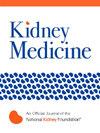A Case Report of Herpes Simplex Virus Associated Peritoneal Dialysis Peritonitis With Novel Use of Intraperitoneal Acyclovir
IF 3.2
Q1 UROLOGY & NEPHROLOGY
引用次数: 0
Abstract
Viral etiologies, such as herpes simplex virus (HSV), for peritonitis can be misclassified as culture negative peritonitis because of poor accessibility of viral testing in the effluent fluid. Inaccurate diagnosis and subsequent ineffective treatment can lead to unnecessary catheter removal for presumed refractory peritonitis. Here, we report a 73-year-old woman with a history of genital HSV-2 on continuous cyclic peritoneal dialysis who presented with HSV-2 related peritonitis. She initially presented with hypotension, suprapubic pain, and cloudy effluent with an elevated white blood cell count preceded by a 1-week history of genital lesions. Elevated cell counts were primarily lymphocyte and monocyte predominant. Bacterial and fungal cultures were negative, and she had minimal improvement in cell counts after 1 week of empiric antibiotics. Effluent was positive for HSV-2. Acyclovir was reconstituted in a 2.5% Dianeal bag and administered via the intraperitoneal route for local effects and avoidance of neurotoxicity. Her cell counts normalized within a week of starting intraperitoneal antiviral therapy and repeat effluent was negative for HSV at 2 weeks. There is one case report describing HSV-2 related peritonitis; however, to our knowledge, this is the first case of viral peritonitis treated with IP acyclovir successfully.
单纯疱疹病毒相关性腹膜透析腹膜炎合并新应用腹腔注射阿昔洛韦一例报告
腹膜炎的病毒病因,如单纯疱疹病毒(HSV),可能被错误地归类为培养阴性腹膜炎,因为在流出液中很难进行病毒检测。不准确的诊断和随后无效的治疗可能导致不必要的导管切除推定难治性腹膜炎。在这里,我们报告了一位73岁的女性,她有生殖器HSV-2的病史,持续循环腹膜透析,她出现了HSV-2相关的腹膜炎。患者最初表现为低血压、耻骨上疼痛、排出物混浊、白细胞计数升高,并有1周的生殖器病变史。细胞计数升高主要以淋巴细胞和单核细胞为主。细菌和真菌培养呈阴性,经验性抗生素治疗1周后,患者细胞计数改善甚微。流出物HSV-2阳性。将阿昔洛韦重组于2.5%狄纳尔袋中,通过腹腔给药,以达到局部作用和避免神经毒性。她的细胞计数在开始腹腔内抗病毒治疗一周内恢复正常,2周时重复流出液HSV阴性。有一例报告描述HSV-2相关的腹膜炎;然而,据我们所知,这是首例用IP阿昔洛韦成功治疗的病毒性腹膜炎。
本文章由计算机程序翻译,如有差异,请以英文原文为准。
求助全文
约1分钟内获得全文
求助全文

 求助内容:
求助内容: 应助结果提醒方式:
应助结果提醒方式:


